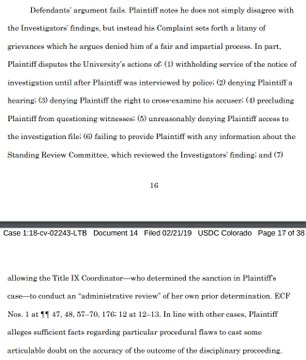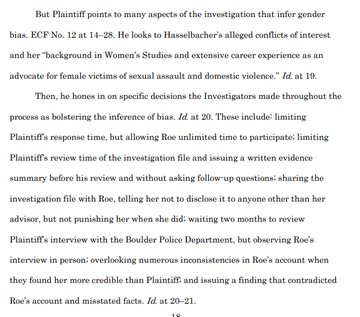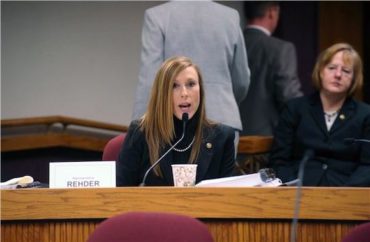Campus investigators wield considerable influence in shaping the evidentiary record on which the fact-finder relies in rendering a determination of innocence or guilt. Current training administered to Title IX investigators focuses on a victim-centered approach that encourages them to “believe the victim.” Such “victim-centered” investigations go by a variety of names, including Start By Believing and “trauma-informed.” Such approaches may be appropriate for counselors and therapists, but contradicts ethical codes that call for investigators to conduct their work in a neutral and objective manner.
In the case of Start By Believing investigations, a California Task Force recently recommended,
“The use of trauma-informed approaches to evaluating evidence can lead adjudicators to overlook significant inconsistencies on the part of complainants in a manner that is incompatible with due process protections for the respondent. Investigators and adjudicators should consider and balance noteworthy inconsistencies (rather than ignoring them altogether)…”
In 2016, SAVE released a report titled, Victim-Centered Investigations: New Liability Risk for Colleges and Universities. http://www.saveservices.org/wp-content/uploads/Victim-Centered-Investigations-and-Liability-Risk.pdf . The report concluded with this recommendation:
SAVE urges university administrators to take prompt measures to end so-called “victim-centered” investigations at their institutions. Simply put, such approaches are inconsistent with the most basic notions of fairness, repudiate the presumption of innocence, and are likely to lead to wrongful determinations of guilt, thereby increasing schools’ liability exposure.
This recommendation apparently was ignored. As a result, lawsuits alleging flawed campus investigations have continued. This is one example:
In 2014 Matt Rolph, then a student at Hobart College in Geneva, NY, was accused of sexually assaulting his long-time girlfriend, “Jane Roe.” A jury cleared Rolph of all charges. https://13wham.com/news/special-reports/college-discredit-acquitted-of-rape-still-shamed
But the college decided to make an example of Rolph. So the college hired Erin Beatty, an outside person to conduct the investigation. Even though Beatty claimed to be a “certified Title IX investigator,” in fact there is no formal process for such a certification.
During the course of the investigation, the investigator (1) did not record any interviews; (2) failed to review text messages sent by Roe; (3) did not question Roe’s motive for delaying her report to school officials; (4) failed to obtain documentation supporting Roe’s claim of medical issues after reporting the alleged rape; and (5) did not conduct any follow-up interviews to resolve inconsistencies among witness statements.
Based on the investigator’s report, the school’s disciplinary panel ruled that Rolph violated the school’s sexual misconduct policy and had him expelled.
So Rolph filed a lawsuit. On September 20, 2017, federal judge Elizabeth Wolford ruled in favor Rolph’s claims of investigative bias. https://casetext.com/case/rolph-v-hobart-william-smith-colls
Following is a partial listing of lawsuits alleging biased investigations in which the judge ruled in favor of the accused student. The first section consists of judicial commentaries on the lawsuits. The second section presents cases in which the alleged student alleged that he was a victim of sexual assault, but the investigator failed to consider that allegation.
Judicial Commentaries
In several of the cases, the judge commented specifically on the flawed investigative procedures:
John Doe v. Washington and Lee University — 2015
In the course of the investigation, Ms. Kozak and Mr. Rodocker ultimately interviewed at least nine people. These witnesses included two of Plaintiff’s four recommended witnesses and at least eight witnesses recommended by Jane Doe, although it is unclear from the pleadings if Jane Doe recommended additional individuals who were not interviewed. When Plaintiff questioned why two of his suggested witnesses were not interviewed, Ms. Kozak stated that the interviews would not be necessary, as they already had enough facts. (Pg. 7 – Opinion)
John Doe v. Georgia Board of Regents — 2016
The Student Sexual Misconduct Policy at Georgia Tech does not allow for a hearing and does not allow for any kind of cross-examination, but rather vests all power in one individual who both investigates and adjudicates. The other due process violations alleged by Plaintiff are also arguably more pressing in light of the single investigator/adjudicator model. The inclusion of admittedly extraneous innuendo from witnesses concerning rumors of Plaintiff’s general character and the refusal to interview certain witnesses is potentially more problematic in an investigator/adjudicator model. (Pg. 25-26)…
To put it bluntly, Mr. Paquette’s [Investigator] testimony at the preliminary injunction hearing about the course of the investigation and the manner in which he made certain investigatory decisions was very far from an ideal representation of due process. (Pg. 37)…Much remains for the Court’s consideration as to whether Mr. Paquette’s investigation veered so far from the ideal as to be unconstitutional. (Pg. 37-38)
John Doe v. The Trustees of the University of Pennsylvania — 2017
Specifically, the Complaint alleges that officials who handled Plaintiff’s case were trained with, among other materials, a document called “Sexual Misconduct Complaint: 17 Tips for Student Discipline Adjudicators” (“17 Tips”). That document warns against victim blaming; advises of the potential for profound, long-lasting, psychological injury to victims; explains that major trauma to victims may result in fragmented recall, which may result in victims “recount[ing] a sexual assault somewhat differently from one retelling to the next”; warns that a victim’s “flat affect [at a hearing] does not, by itself, show that no assault occurred”; and cites studies suggesting that false accusations of rape are not common.
At the same time, the document advises that the alleged perpetrator may have many “apparent positive attributes such as talent, charm, and maturity” but that these attributes “are generally irrelevant to whether the respondent engaged in nonconsensual sexual activity.” It also warns that a “typical rapist operates within ordinary social conventions to identify and groom victims” and states that “strategically isolating potential victims [] can show the premeditation” commonly exhibited by serial offenders.
In light of these allegations, we conclude that the Complaint plausibly alleges that Defendant breached the contractual requirement that it train Hearing Panel members “to fulfill their responsibilities as adjudicators according to the procedures and policies outlined” in the Disciplinary Procedures and “to ensure compliance with Title IX.” In light of these same allegations, we also conclude that the Complaint plausibly alleges that the investigators were not “appropriately trained as investigators in handling sexual violence cases.”
John Doe vs. Brown University — 2018
[Investigator] Perkins’ assessment that there was insufficient evidence to support [accused student] Doe’s fabrication claim was particularly problematic given that she had refused to ask for evidence that might have proven it so and been exculpatory to Doe. …
The problem here was that Perkins made the initial decision to include the conspiracy claim and corresponding character evidence, but then chose not to complete the evidence-gathering, and went on to say that there was insufficient evidence to support Doe’s fabrication claim. Because of this, her failure to request the text messages between Ann and Witness 9 was a violation of Doe’s right “[t]o be given every opportunity to . . . offer evidence before the hearing body or officer.”
John Doe v. University of Southern California — 2018
But it is not too heavy a burden to require that students facing disciplinary action be informed of the factual basis for the charges against them. A charge of “encouraging or permitting others to engage in misconduct” that can penalize completely different behavior based on the decision-maker (SJACS versus the Appeals Panel), without notice to the student, is indeed as standardless as the undefined “gross incompetence” in Wheeler. (Pg. 25)…Requiring John to request access to the evidence against him does not comply with the requirements of a fair hearing. (Pg. 29)
John Doe v. The University of Mississippi, et. al. — 2018
Turning then to Doe’s arguments regarding Ussery, he says her investigation was biased and flawed, that it resulted in an unfair report that was presented to the Judicial Council as the official report of the Title IX Coordinator, and that the panel itself had been trained in a way that prejudiced Doe’s ability to be heard. As to that training, Doe makes the following points: (1) the training material “advises that a ‘lack of protest or resistance does not constitute consent, nor does silence,’” (2) it “advise[s] the panel members that ‘victims’ sometimes withhold facts and lie about details, question if they’ve truly been victimized, and ‘lie about anything that casts doubt on their account of the event,’” and (3) it explains that “when Complainants withhold exculpatory details or lie to an investigator or the hearing panel, the lies should be considered a side effect of an assault.”
This is a he-said/she-said case, yet there seems to have been an assumption under Ussery’s training materials that an assault occurred. As a result, there is a question whether the panel was trained to ignore some of the alleged deficiencies in the investigation and official report the panel considered.
It is therefore plausible that the scales were tipped against Doe to such a degree that further procedural safeguards may have lessened the risk of an erroneous deprivation.
Andrew Doe v. The University of Mississippi, et. al. — 2019
Turning then to Doe’s arguments regarding Title IX Coordinator, he says her investigation was flawed because the panel itself had been trained in a way that prejudiced Doe’s ability to be heard.
As to the training, Doe makes the following points: (1) the training material “provides that just because an individual does not protest or resist sexual activity their silence and lack of resistance does not constitute consent,” (2) it “provides that when both parties are intoxicated, findings are to be made in favor of the complainant, who is typically female,” and (3) the materials “advise the panel members that ‘victims’ sometimes withhold facts and lie about details, question if they’ve truly been victimized[,] and ‘lie about anything that casts doubt on their account of the event.’”
Taken as a whole, the Court concludes that Doe has stated a plausible claim. This is a consent-based case in which the victim did not appear before the hearing panel, yet there seems to have been an assumption under Ussery’s training materials that an assault occurred. As a result, there is a question whether the panel was trained to ignore some of the alleged deficiencies in the investigation and official report the panel considered. Coupled with the alleged deficiencies in the investigation, it is plausible that the scales were tipped against Doe to a degree that further procedural safeguards may have lessened the risk of an erroneous deprivation.
When the Accused Student Allegedly is the True Victim of the Sexual Assault
In several lawsuits filed by male accused students, institutions failed to investigate evidence developed during the course of the institution’s own investigation that the accused student was a victim of sexual misconduct according to school policies: Rollins College (2017 and 2019), Miami University, Amherst College, Williams College, and Drake University.
Two of these cases are described below:
Amherst College – 2017
In Amherst, the male plaintiff (Doe) had been incapacitated when the female complainant gave him oral sex. However, the school found the male student responsible for sexual assault. It was not until the accused filed his lawsuit that discovery revealed text message that proved his claim that he was the victim.
The plaintiff in Amherst asserted several causes of action, including that the school had violated Title IX based on selective enforcement and deliberate indifference:
In order to prevail on a selective enforcement claim, Doe was required to to establish that his gender was a “motivating factor behind either the College’s decision to pursue disciplinary action . . . or its decision as to the severity of punishment . . .” The Court found that the accused student plaintiff had met his burden on this claim, because he had alleged that Amherst encouraged the female complainant to file her complaint but did not do the same for him. Amherst did not even investigate his allegations despite his repeated allegations that he had had been “blacked out” when the female complainant initiated sexual activity with him.
The plaintiff’s deliberate Indifference claim required him to show that Amherst was deliberately indifferent when handling his sexual harassment claim. The court found the male student had met this burden after he asserted that the female complainant initiated sexual activity with him while he was incapacitated. According the Court, “the College did not take even minimal steps to determine whether [the plaintiff] should have been viewed as a victim under the terms of the policy.”
Rollins College – 2019
On January 16, 2019 U.S. District Court Judge Roy Dalton allowed a lawsuit against Rollins College – the second against the institution within two years — to move forward under the theories of breach-of-contract and selective enforcement.
According to the male accused student, his female accuser had taken advantage of him sexually while he was inebriated. During its investigation, the college ignored evidence in favor of the male and overlooked contradictions in the woman’s testimony.
The judge determined that the complaint raised the possibility that Rollins had effectively discriminated against the male student by: rejecting testimony from his witnesses “based, in part, on the male witnesses’ fraternity associations,” while allowing testimony from his accuser’s sorority witnesses; “excus[ing] any inconsistencies” in her testimony concerning whether she had “verbalized consent;” and made “irrelevant, inflammatory, and conclusory statements” about the accused. Rollins College prejudged the male accused student as guilty in order “to protect its image,” according to Judge Dalton.


 Accuser broke confidentiality with no sanction
Accuser broke confidentiality with no sanction



 UPDATED
UPDATED